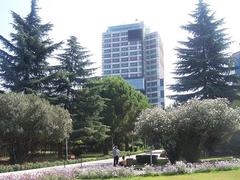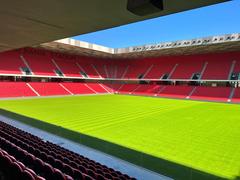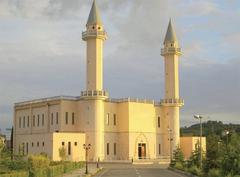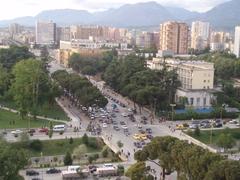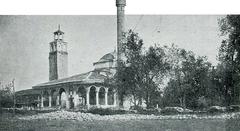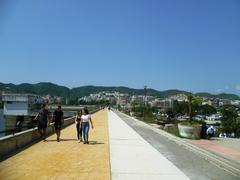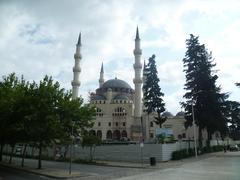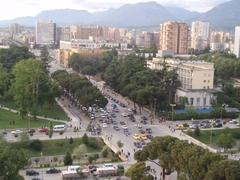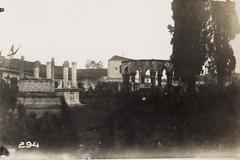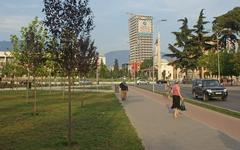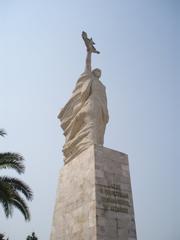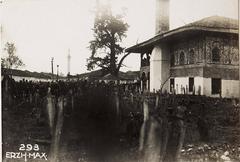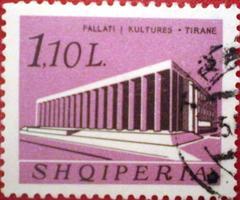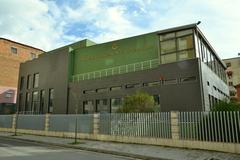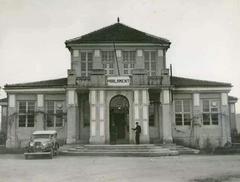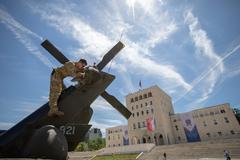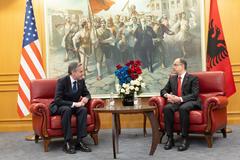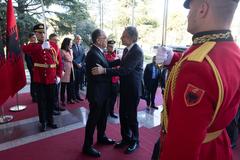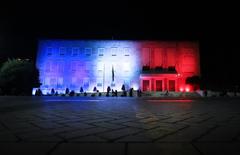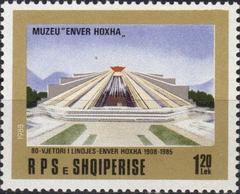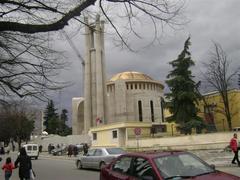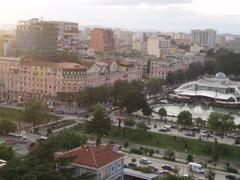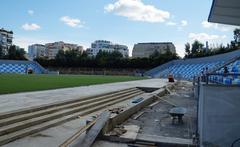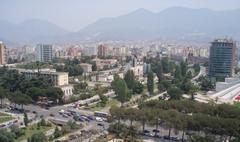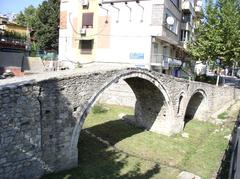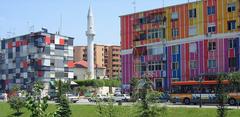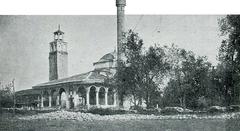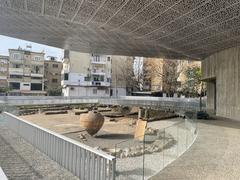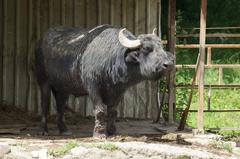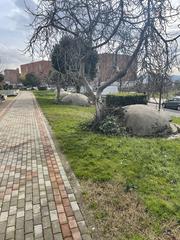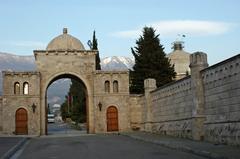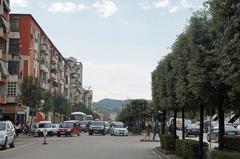Pioneers of Enver Tirana: Visiting Hours, Tickets, and Historical Significance
Date: 04/07/2025
Introduction to the Pioneers of Enver Historical Site
The Pioneers of Enver stand as a profound emblem of Albania’s communist-era youth movement. Rooted in World War II through the clandestine Debatik organization, the movement embodied communist ideals and anti-fascist resistance. Under Enver Hoxha, it evolved into a national institution, shaping generations of Albanian children through education, socialization, and socialist indoctrination. Today, Tirana offers visitors the chance to engage with this layered legacy at sites like the Pyramid of Tirana, former Pioneers’ Palaces, and Enver Hoxha’s former residence—each providing unique perspectives on Albania’s complex history (Wikipedia; enver-hoxha.net; globhistory.org; evendo.com).
This comprehensive guide details the historical background, cultural significance, and practical visitor information for these sites, ensuring travelers can fully appreciate Albania’s rich past and the ongoing urban and cultural renaissance in Tirana (archeyes.com; Ocnal). It also highlights nearby attractions such as Skanderbeg Square, the National Historical Museum, and the Bunk’Art museums, for a broader understanding of Albania’s 20th-century transformation (The Crazy Tourist; Salt in Our Hair).
Origins: From Debatik to a National Movement
The roots of the Pioneers of Enver go back to World War II, when Albania faced fascist occupation. The organization began as Debatik (Djemtë E Bashkuar Anëtarë Të Ideve Komuniste—United Boys of Communist Ideas), founded on February 10, 1942 (Wikipedia). Debatik’s mission was to foster communist values among youth and support the partisan struggle, setting a model for ideological education and mobilization.
After the war, Debatik transitioned into the Organization of Pioneers (Organizata e Pionierëve), reflecting the new socialist government’s drive to embed communist values in every aspect of society, especially youth education (Wikipedia; enver-hoxha.net).
The Organization of Pioneers: Structure and Activities
The Organization of Pioneers became a mass movement for children up to age 14, modeled after other socialist states. Supervised by the Labour Youth Union, it operated through a hierarchical network from local to national levels. Membership was both an honor and an expectation.
Main Activities
- Pioneer Camps: National summer camps combined recreation, ideological education, and collective living (Wikipedia).
- Pioneers’ Palaces: Urban centers offering extracurriculars from arts to sciences.
- Competitions and Festivals: Annual national contests in arts and sciences.
- Publications: Magazines such as Horizonti (science) and Pionieri (general interest, ages 8–14).
Children wore uniforms, participated in parades, and took loyalty oaths—solidifying collective identity and adherence to the party’s values.
Renaming and the Cult of Personality
In 1985, following Enver Hoxha’s death, the organization was renamed the Pioneers of Enver (Pionierët e Enverit), strengthening its association with the leader (Wikipedia). This renaming was part of a wider cult of personality, with monuments and institutions across Albania bearing Hoxha’s name and legacy (enver-hoxha.net).
Decline and Dissolution
Communism’s collapse in 1991 led to the Pioneers’ dissolution. Albania’s shift to democracy prompted the repurposing or abandonment of many former Pioneer facilities (Wikipedia). The organization’s legacy remains debated—seen by some as a system of indoctrination and by others as a formative aspect of childhood.
Visiting the Pioneers of Enver Sites in Tirana
Tirana preserves several sites that reflect the Pioneers’ history and Albania’s socialist past.
The Pyramid of Tirana
- Historical Significance: Erected in 1988 as a museum to Enver Hoxha, the Pyramid was central to youth activities during communism (Votra Magazine; Visit Tirana).
- Today: After a transformative redesign in 2023, it serves as a hub for youth, technology, and creative industries.
- Visiting Hours: Daily, 10:00 AM–6:00 PM (may extend during events).
- Tickets: General entry is free; special exhibitions or events may require a ticket.
- Accessibility: Fully accessible with ramps and pathways.
- Guided Tours: Available by appointment via the Tirana Tourism Office.
Former Pioneers’ Palaces
Many former Pioneers’ Palaces now function as cultural or educational centers. These spaces host art exhibitions, workshops, and historical displays.
- Visiting Hours: Typically 10:00 AM–5:00 PM on weekdays.
- Tickets: Usually free; some events may charge.
Visitor Tips
- Combine these sites with a broader tour of Tirana’s communist-era landmarks.
- Wear comfortable shoes; several sites are best explored on foot.
- Utilize the Audiala app for self-guided tours and augmented reality experiences related to Albania’s history.
Numbers and Impact
The Pioneers of Enver counted hundreds of thousands of members at their peak, encompassing nearly all children aged 8–14 (Wikipedia). The movement deeply influenced Albanian society by shaping collective identity and reinforcing state loyalty, though at the expense of individual expression.
Contemporary Reflections
Today, the memory of the Pioneers of Enver is woven into Tirana’s cultural fabric. Sites such as the Pyramid and former Pioneers’ Palaces allow visitors to reflect on the complexities of Albania’s past, the legacy of youth indoctrination, and the ongoing process of societal transformation.
FAQ: Pioneers of Enver and Related Sites
Q: What are the visiting hours for the Pyramid of Tirana?
A: Typically open daily from 10:00 AM to 6:00 PM.
Q: Is there an entrance fee?
A: General entry is free; some exhibitions may have a nominal fee.
Q: Are guided tours available?
A: Yes, through the Tirana Tourism Office or local operators.
Q: What is the significance of the Pioneers of Enver?
A: They were the principal communist youth organization, playing a major role in education and ideological formation during Albania’s socialist era.
Visiting Enver Hoxha’s Former Residence: History, Tours, and Visitor Tips
Overview
Enver Hoxha’s former residence offers a unique lens into Albania’s socialist period, reflecting both the privileges of the elite and the values promoted under communism. Today, it serves as a museum that preserves interiors, artifacts, and photographs depicting life during Hoxha’s rule (globhistory.org; evendo.com).
Socialist Realism and State Culture
The residence showcases the aesthetics of Socialist Realism—Albania’s state-mandated artistic style—and highlights the Party’s control over public culture and youth organizations (enverhoxha.info).
Everyday Life and Social Stratification
Located in one of Tirana’s most exclusive areas, the residence contrasts the comfort of the elite with the austerity experienced by ordinary citizens. Guided tours illuminate these social differences and offer a reflective perspective on Albania’s past.
Practical Visitor Information
- Opening Hours: Tuesday–Sunday, 9:00 AM–5:00 PM; closed Mondays and public holidays.
- Tickets: ~500 ALL for adults; discounts for students/seniors; children under 7 free.
- Booking: Onsite or in advance via official channels.
- Guided Tours: Available in English and Albanian; 45–60 minutes.
- Accessibility: Partial; check in advance for mobility needs.
- Location: Near Rruga Ismail Qemali, central Tirana; walkable from Skanderbeg Square and the National Historical Museum.
- Photography: Permitted in most areas; observe posted restrictions.
- Etiquette: Be respectful—this site has deep emotional significance for many Albanians.
The Residence in Tirana’s Historical Network
The residence is part of a broader constellation of communist-era sites, including the Pyramid, National Historical Museum, and Bunk’Art museums (travellingking.com). Together, these offer a comprehensive view of Albania’s 20th-century history.
FAQ: Enver Hoxha’s Residence
Q: What are the opening hours?
A: Tuesday–Sunday, 9:00 AM–5:00 PM.
Q: How much are tickets?
A: About 500 ALL for adults; discounts for students/seniors; children under 7 free.
Q: Are guided tours available?
A: Yes, in English and Albanian.
Q: Is photography allowed?
A: Generally yes, except in some restricted areas.
Q: Is the site accessible?
A: Partial accessibility—contact ahead for specific needs.
Pyramid of Tirana: Visiting Hours, Tickets, and Key Historical Sites
Introduction
The Pyramid of Tirana remains one of the city’s most recognizable landmarks, offering insight into Albania’s unique architectural and political history. Originally built as a museum for Enver Hoxha, it has been repurposed as a youth, technology, and cultural innovation hub (archeyes.com; Ocnal).
History, Transformation, and Visitor Experience
Background and Significance
Built in 1988, the Pyramid was designed by a team including Hoxha’s own family members (The Crazy Tourist). Post-communism, it served various functions—from conference center to NATO base—before falling into disrepair and being reclaimed by Tirana’s youth as an informal gathering spot.
The 2023 redesign by MVRDV and iRI Architecture transformed the building into a vibrant, multi-use center, preserving its iconic shape while inviting the public to participate in its new identity (archeyes.com; worldarchitecture.org).
Architecture and Symbolism
The Pyramid’s angular, concrete form is both a monument to the past and a symbol of Albania’s resilience and adaptability. The renovation introduced vivid modular spaces for creative industries, education, and public events, with accessible ramps leading to panoramic city views (architizer.com).
Visiting Hours and Tickets
- Hours: Daily, 10:00 AM–6:00 PM (extended during events).
- Tickets: General access is free; some events/exhibitions may require a ticket (300–500 ALL).
- Accessibility: Fully accessible.
- Tours: Book through the official site or Tirana Tourism Office.
What to Do at the Pyramid
- Climb the ramps for panoramic views.
- Visit TUMO Tirana, the youth tech center.
- Explore exhibitions and events in art, technology, and innovation.
- Enjoy cafés and public spaces within and around the Pyramid.
Other Key Historical Sites in Tirana
- Skanderbeg Square: The heart of Tirana, surrounded by museums and historical buildings (Salt in Our Hair).
- Bunk’Art Museums: Immersive museums inside massive bunkers, detailing Albania’s communist and military history (The Crazy Tourist).
- Blloku District: Former elite quarter, now a lively area for dining and nightlife.
- Dajti Mountain: Accessible via cable car for hiking and city views.
- National Historical Museum: Comprehensive exhibits from ancient to modern Albania (Salt in Our Hair).
Local Culture and Practical Information
- Transport: Tirana International Airport is 30 minutes from the city center via shuttle or taxi (Salt in Our Hair). Central sites are walkable; buses and taxis are available.
- Currency: Albanian lek (ALL); cash is common for small transactions (Indie Traveller).
- Best Time to Visit: May–June and September for pleasant weather.
FAQ: The Pyramid of Tirana
Q: What are the visiting hours?
A: Daily, 10:00 AM–6:00 PM.
Q: Is there an entrance fee?
A: General access is free; some events/exhibitions may charge.
Q: Are guided tours available?
A: Yes, by appointment.
Q: Is the Pyramid accessible?
A: Yes, fully accessible.
Q: What are other recommended sites nearby?
A: Skanderbeg Square, Bunk’Art museums, Blloku, Dajti Mountain, National Historical Museum.
The Pyramid of Tirana: A Symbol of Transformation
From Authoritarian Monument to Cultural Hub
Originally a monument to Enver Hoxha, the Pyramid’s bold concrete design reflected the power and aspirations of Albania’s socialist regime. Its post-communist evolution—from disuse to a vibrant youth and tech center—embodies the country’s journey from isolation to renewal (archeyes.com; worldarchitecture.org).
The MVRDV Redesign
The recent redesign preserved the Pyramid’s form but infused it with color, modular creativity, and public accessibility. TUMO Tirana, a free digital education center for youth, anchors the new interior, while open steps invite visitors to “walk all over” a former symbol of power (architizer.com).
Symbolic and Social Impact
The Pyramid’s transformation is a victory for collective memory and civic engagement, blending historical acknowledgement with forward-focused innovation. It has become a center for community events, creative industries, and youth education—reflecting Albania’s vibrant and youthful society.
Visiting Essentials
- Location: Central Tirana, near major attractions.
- Safety: The area is tourist-friendly (albaniafaq.com).
- Virtual Tour: Check the official Pyramid website for digital media, interactive maps, and event updates.
Summary and Cultural Importance
Exploring the Pioneers of Enver sites in Tirana offers key insights into Albania’s socialist legacy, youth socialization, and contemporary efforts to reclaim history for educational and creative purposes. The transformation of the Pyramid, alongside other sites like Enver Hoxha’s residence and former Pioneers’ Palaces, illustrates a broader narrative of resilience and renewal. Together, these destinations provide a richly educational experience for history enthusiasts and curious travelers alike (Pyramid Official Website).
Sources and Further Reading
- Wikipedia
- enver-hoxha.net
- Votra Magazine
- Visit Tirana
- globhistory.org
- evendo.com
- The Crazy Tourist
- Ocnal
- archeyes.com
- worldarchitecture.org
- architizer.com
- Salt in Our Hair
Images to include:
- Exterior view of Enver Hoxha’s former residence in Tirana (alt: “Enver Hoxha former residence Tirana historical site”)
- Interior rooms with Socialist Realism artifacts (alt: “Socialist Realism artifacts inside Enver Hoxha residence”)
- Map of Tirana with historical sites highlighted (alt: “Map of Tirana showing Enver Hoxha residence and historical sites”)
Suggested media:
Explore, reflect, and immerse yourself in the rich history and evolving culture of Tirana.
